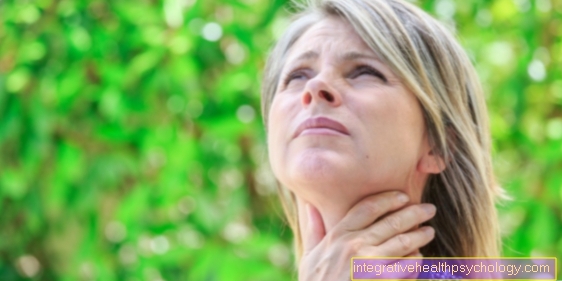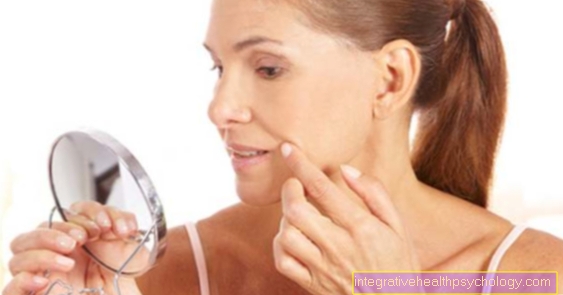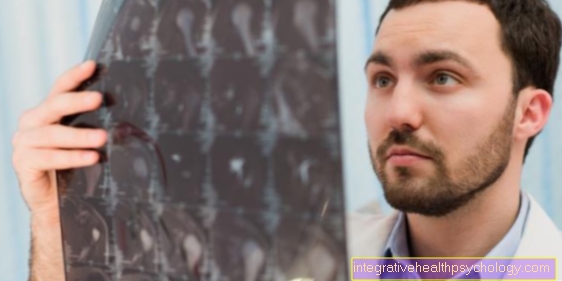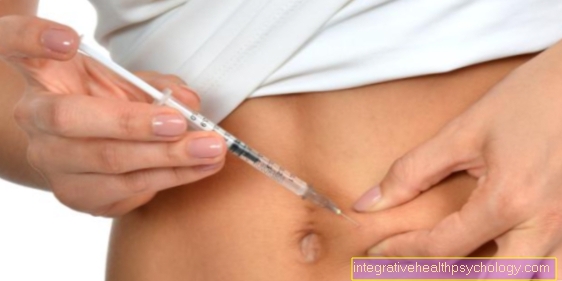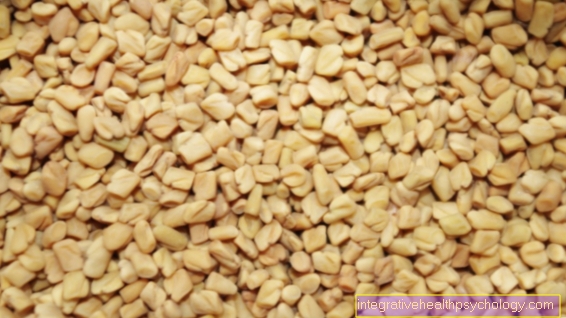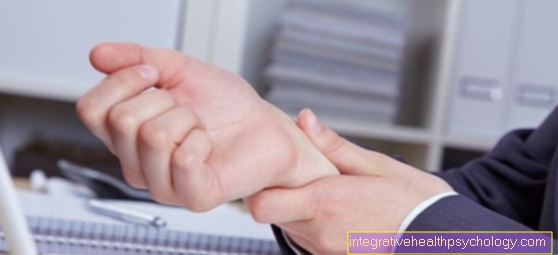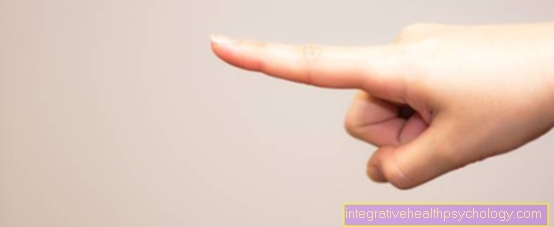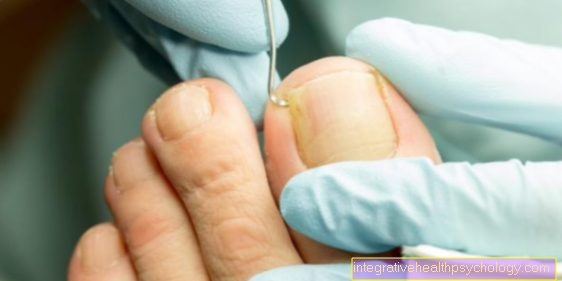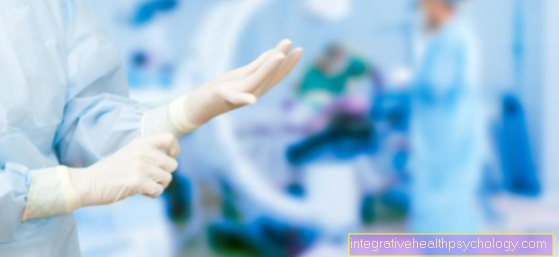Left kidney pain
Kidney pain on the left side
Kidney pain can be bilateral, left-sided, or right-sided. Depending on where it is located, the pain suggests different diseases.
You might also be interested in: Pain in the kidney area

If the pain occurs only on the left side, a pathological process is most likely to be expected, which only takes place in the left kidney. If you tap the area of the left kidney with the edge of your hand (to the left of the spine about two to three fingers wide above the palpable iliac crest) and this triggers or worsens the pain, this indicates that the kidney really is is the cause of the pain. In some cases, back pain caused by the spine or diseases or inflammatory processes in other abdominal organs (such as the ovary on the left side or the urinary bladder) can simulate kidney pain.
You might also be interested in: Kidney pain on the right side - causes and therapy
causes
Typical causes of pain in the left kidney are also the same as for the right kidney.
The most common cause of unilateral kidney pain is the different types of kidney stones. These can develop due to various factors, mostly they arise due to diet, autoimmune diseases or anatomical irregularities.
The so-called migrating kidneys can also cause severe pain in the kidney area. This is caused by abnormal mobility in the kidneys, which can sink very low, obstructing the flow of urine, which in some cases can be extremely painful.
Another cause of left-sided kidney pain can be kidney (pelvic) inflammation. This disease, also known as "kidney cold", can be caused by drafts or generally when the kidneys are not kept warm enough, for example when you sit on a cold floor for a long time or wear wet bathing suits or when the kidneys are cold for a longer period of time does not cover. If one of these risk factors has primarily affected the left one (for example due to a draft from the left), the result is pure left-sided or left-sided pain. Furthermore, kidney failure can trigger pain in the kidneys. However, this disease usually affects both kidneys at the same time and is therefore not likely if the pain only occurs on the left.
Very rare causes are cysts (= fluid-filled cavities), tumors or an inflammation of the filter apparatus of the kidneys, the so-called glomeruli (= glomerulonephritis).
From a psychosomatic point of view, the kidneys represent the partnership area. If no physical cause for the left kidney pain can be found, psychosomatic causes should be considered. Often people who are in a conflict with a loved one or their partner complain of kidney pain. This is often difficult to recognize and accept, but it is important that such a person is treated on a psychosomatic level.
Read more on this topic: How can I relieve kidney pain?
Illustration causes and therapy of kidney pain

Kidney pain
(Flank pain in the
lateral abdominal region)
- Left kidney - Ren sinister
- Spine -
Columna vertebralis - Right kidney - Ren dexter
- Ureter - Ureter
Causes:
A1 - Acute primary
(uncomplicated)
Pelvic inflammation -
Pyelonephritis
(triggered by bacteria in the urinary tract)
A2 - Acute secondary
(complicated)
Pelvic inflammation
(due to drainage disturbances, congestion
in urinary tract, enlarged prostate)
B - kidney stones - nephrolites
Urolithiasis -
(Urinary stone formation in the kidney)
C - kidney cancer (malignant kidney tumor) -
Renal cell carcinoma
Therapy:
D - Antibiotic Treatment -
Broad spectrum antibiotics, paracetamol,
Novalgin
E - Sufficient drinking amount (2-3 liters),
regular exercise
F - home remedies and nettles
Cranberry supplements, kidney and
Bubble tea, juniper, dandelion leaves
G - heat application, hot water bottle,
Use of heat lamps,
warming baths, kytta ointment,
Horse balm
You can find an overview of all Dr-Gumpert images at: medical illustrations
Other causes
Ultimately, there are numerous causes of kidney pain. The most common are:
1. Kidney stones (Latin: nephrolithiasis)
Around 4% of the German population suffer from kidney stones, with the incidence increasing sharply with age. In many patients they do not cause any symptoms and are discovered by chance during routine examinations. However, if the stone is e.g. into the left ureter (lat .: Ureter) and gets stuck, those affected feel severe pain in the area of the left kidney.
But how do kidney stones arise? Individual urine components (including calcium salts and uric acid) can precipitate into crystalline stones of different sizes if the urine composition changes. Particularly affected are e.g. Patients with untreated gout!
The kidney stones are often only 1-3 millimeters in size - in severe cases, however, they can also be several centimeters in size.
Depending on the exact location in the kidney, the symptoms develop differently. In addition to severe, colicky pain, bloody urine can often be observed.
2. Kidney inflammation
Main cause of kidney inflammation (lat .: Pyelonephritis) are "ascending" infections of the lower urinary tract, e.g. Cystitis. This is how bacteria (especially E. coli), very rarely fungi, via the ureters into the kidney and cause the painful inflammation there.
Usually the disease occurs unilaterally, e.g. left, up. Symptoms that occur suddenly, severe pain in the affected kidney, fever, chills and severe feeling of illness are the typical symptoms. Therefore, even a simple cystitis should always be taken seriously and treated, otherwise there is a risk of a far more problematic kidney pelvic inflammation.
Because in the worst case, life-threatening blood poisoning, starting from the kidney (lat .: Urosepsis) occur. The first symptoms may be a noticeable increase in heart rate (Tachycardia), as well as high blood pressure.
3. Polycystic kidney disease, cyst kidneys
Far less common than pelvic inflammation or kidney stones, polycystic kidney disease can be the cause of left-sided kidney pain. In this genetic disease, fluid-filled cysts develop in the kidney area, and rarely in other organs.
A distinction is made between a dominantly inherited variant, which occurs relatively frequently with 1: 1000, and a recessive inherited variant, with a frequency of less than 1: 10,000. While the first form of the disease can usually only be observed between the 2nd and 3rd decade of life, newborns already suffer from the recessively inherited form.
In addition to severe kidney pain, usually one-sided at the beginning, patients often report high blood pressure, recurrent bladder infections, bloody urine and kidney stones. Around half of those affected develop chronic kidney failure by the age of 50 ("Kidney failure“) And therefore have to have regular dialysis, also popularly known as blood washing.
Symptoms
Typical of involvement of the left kidneys, as is common for the kidneys, is the so-called flank pain.
These express themselves as a dull, pressing pain in the upper back of the abdomen or in the middle area of the back. This flank pain is also referred to as "pounding pain", as the pain intensifies when the examiner pats the left back with the edge of his hand from the pelvis upwards.
Both increased and decreased urination can be pathological and indicate damage to the kidneys.
The color of the urine should ideally be almost clear.
Brown or red discolouration or even foamy urine should always be reported to the doctor.
An inflammation of the renal pelvis (= pyelonephritis) is usually accompanied by a bladder infection (= cystitis) and manifests itself in frequent, painful urination with accompanying kidney pain. At the latest when a fever occurs, a doctor should be consulted urgently.
Renal colic of the left kidney manifests itself with regularly recurring severe pain in the left kidney. The cause are the so-called kidney stones, which the body tries to remove from the body with the help of regular muscle movements through the ureter.
Read more on the topic: Left flank pain
Kidney pain combined with nausea
Kidney pain on the left combined with nausea can be a sign of inflammation of the kidney pelvis (pyelonephritis). This can be triggered either by an ascending urinary tract infection or by an obstruction of the urine flow. For example, stones in the ureter or in the renal pelvis can lead to this. Due to the back pressure of the urine, the renal pelvis provides a good environment for bacteria that can lead to inflammation.
Kidney inflammation is often associated with a relatively poor general condition. Fever, tiredness, headache and nausea and vomiting often occur.
In addition, kidney colic, such as that caused by kidney stones, can cause pain so severe that those affected complain of nausea. Here the kidney pain is very strong and has a wave-like pain curve. This means that they constantly increase in their intensity and then become more bearable again.
You might also be interested in: Kidney pain with nausea
Breath-dependent kidney pain
Breath-dependent kidney pain can occur because breathing changes the position of the diaphragm and, depending on the breathing phase, can press on the kidneys. When you inhale, it moves Diaphragm down and if there is an inflammation of the kidney or the renal pelvis, pain can be caused by the Contact with the kidney cause.
In addition, breath-dependent pain can be associated with a Urinary flow disorder go along and for example through one Kidney stone or one Ureteral stone be conditional.
Kidney pain when breathing and coughing
Our kidneys are in the so-called "Kidney camp“Just below the diaphragm, at the level of the first and second lumbar vertebrae. A total of three parts can be distinguished:
- Organ capsule: Thin capsule made of connective tissue, which lies directly on the kidneys.
- Kidney fat pads: fat stores with a cushioning function for the sensitive organs
- Renal fascia: encloses kidney fat pads and in connection with the diaphragm
Since the diaphragm and kidney are in close spatial contact with each other, Our kidneys move indirectly by several centimeters when we breathe. These passive movements, caused by the lifting and lowering of the diaphragm, can be used in e.g. Left-sided kidney disease lead to breath-dependent pain. Especially when you cough, the diaphragm moves up and down a lot and can therefore lead to severe kidney pain. Interesting to know is the fact that only the kidney capsule has nerve fibers running through it. So if we feel pain, the capsule is always responsible.
Therapy - what to do with left kidney pain?
Left kidney pain can be an indication of numerous diseases. Therefore, it is It is essential to clarify long-lasting or sudden, severe pain with a doctor allow. In particular, high pressure or knock sensitivity in the area of the flanks, i.e. the kidney bed, indicate a disease of the important organ. If you also have the following symptoms, you should urgently consult a doctor:
- Fever and chills
- Discolored urine (e.g. bloody)
- Urination disorders (e.g. Urinary retention)
- Vomiting and diarrhea
- Spasmodic pain
- Extreme weakness
- Water retention (Edema)
If you only have mild kidney pain, e.g. As part of your period, or the time you need to go to a doctor, some measures can provide relief.
1. Heat - used to treat kidney pain
Keep your aching left kidney warm! So can the Blood circulation of the sensitive organ increased possible cramps are released and the muscles relax. In principle, are suitable for this Hot water bottles, Heat pad, Woolen scarves, Kidney warmer or special Heat patch, such as. ThermaCare®, from the pharmacy. To prevent kidney pain, it is also advisable to wear undershirts or T-shirts under clothing in the cold winter months.
2. Drink a lot - to treat kidney pain
If you have kidney pain, you should drink as much as possible! This is how the Irrigation of the kidney and urinary tract (Ureter, bladder, etc.) promoted and possible pathogens cannot settle so easily. It is best to use warm drinks, such as Herbal teas back. Nettle or goldenrod extracts in particular promote urinary excretion (Diuresis) and thus flushing the kidney.
However, kidney pain is a very serious symptom and must be taken seriously in any case!
3. Home Remedies - Used to treat kidney pain
For complaints caused by the kidney, the most important thing is much to drinkso that the kidneys are well flushed and possible pathogens flushed out can be.
Tea is particularly suitable for this. Especially Green tea, special kidneys- and Bubble tea or Dandelion tea are recommended as they have a diuretic effect.
Also warmth is generally beneficial for kidney pain. Care should be taken to keep the kidneys warm, especially at low temperatures outside. In addition, you can warm baths or Hot water bottles Relieve the pain in the flank area.
If it's a Kidney stone which is responsible for the kidney pain, it can help Lemon juice to drink. This allows the kidney stone to be dissolved in a natural way. For this, a glass of water should be mixed with the juice of a lemon and drunk. You can do this several times a day.
Also parsley becomes a analgesic, anti-inflammatory and diuretic effects said. A bunch of parsley should be chopped up and boiled in one liter of water for 10 minutes. This tea can then be drunk throughout the day.
You might also be interested in: Indian kidney and bladder tea, Nutrition for urinary stones
Kidney pain after taking antibiotics
In extremely rare cases, after Antibiotic therapy interstitial nephritis can be observed. In this clinical picture, especially kidney tubes, blood vessels, connective tissue of the kidney become inflamed and cause unilateral, e.g. left kidney pain. Exact figures on the frequency of the disease are not available because in many cases it is symptom-free.
Too high a dose of antibiotics, but also allergic reaction can trigger the clinical picture. Not infrequently, accompanying the described kidney pain skin rash and fever on.
Fortunately, the prognosis for interstitial nephritis is extremely favorable!
Kidney pain associated with exercise
Usually there is kidney pain not dependent on movement. That is one criterion of how kidney pain is differentiate from back pain to let. While kidney pain cannot be provoked by movement, kick Back pain As a general rule when moving or increased with certain movements.
So if you have left back pain in the kidney area, you should definitely have the Back examined become. Here you can Deformations of the spine (for example scoliosis) or a muscular imbalance Cause discomfort.
When kidney pain on the left side relieved by movement so is a possible cause Kidney stone or a Stone in the ureterthat was the cause of the pain and that came off with the movement.
Recommendations from our editorial team: Pain in scoliosis, Ureteral stone, Kidney stones
Kidney Pain During Pregnancy
During the pregnancy can be a massive magnification of the uterus (lat .: uterus) observe.
Especially in the last third of pregnancy, the uterus presses on practically all organs in the lower abdomen and pelvis, including the urinary organs. In particular bladder and ureter can be affected. This also explains why pregnant women have to urinate frequently.
By narrowing the ureter, the Urine backed up in both kidneys and cause enlargement of the renal pelvis.
The doctor then speaks of "urinary congestion".
Step as a consequence Strength, colicky kidney pain on. Due to anatomical conditions, the right kidney is affected more frequently in many cases. However, kidney pain in the left side can also be observed. Affected women also often feel the need to urinate, but are unable to urinate.
The diagnosis of urinary congestion can easily be made by the doctor using one Ultrasound device put.
If anticonvulsant medication does not provide relief, it is possible to keep the ureters open by using splints. If left untreated, the disease can have serious consequences, so you should definitely see a doctor.
Since urinary congestion increases during pregnancy, pregnant women are also at increased risk of developing an inflammatory process in the kidneys, such as pelvic inflammation. Therefore, you should drink enough during pregnancy and protect your kidney region from the cold.
Diagnosis
For pain in the left kidney can be a simple Ultrasound examination and a urine test will bring clarity.
The person affected can often determine changes by closely observing their own urine, which can help to identify the cause.
In the case of inflammation of the kidney pelvis, treatment with an antibiotic is sufficient in most cases, since bacteria that rise up are the cause of kidney pelvic inflammation and these can be easily eliminated with antibiotics.
Only in severe cases is a Hospitalization necessary when the germs from the kidney, which is very well supplied with blood, spread through the bloodstream throughout the body and a Blood poisoning (= Sepsis) cause.


